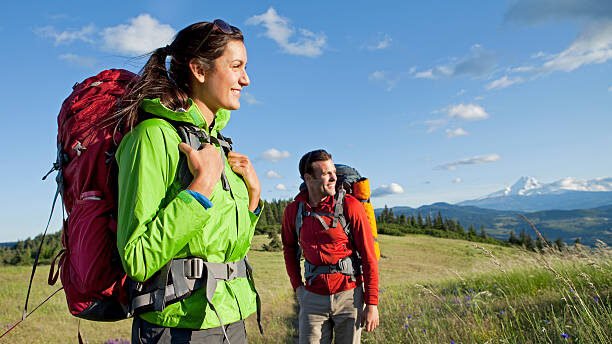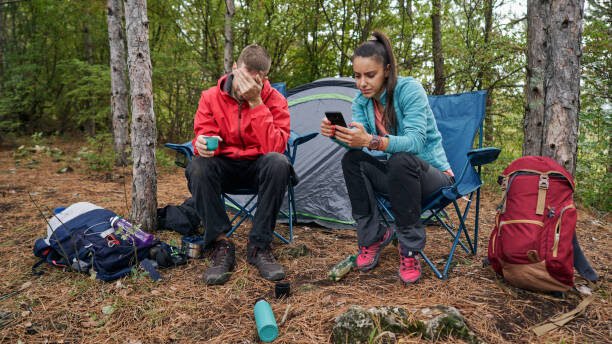Contents
- 1 Introduction to Backpacking Camping Essentials
- 2 Conclusion
- 3 FAQs (Frequently Asked Questions)
- 3.0.1 What should I pack for a backpacking camping trip?
- 3.0.2 How can I minimize my environmental impact while backpacking?
- 3.0.3 What should I do in case of an emergency while backpacking?
- 3.0.4 Are there any specific safety precautions I should take when encountering wildlife?
- 3.0.5 What are some tips for choosing a suitable campsite?
Introduction to Backpacking Camping Essentials
Embarking on a backpacking camping trip allows you to connect with nature intimately, explore remote terrains, and revel in the thrill of self-reliance. Whether it’s a weekend escapade or an extended expedition, meticulous preparation and essential gear are pivotal for a rewarding adventure.

1. Choosing the Right Gear
In the realm of backpacking camping, every gram matters. Opt for lightweight, compact gear that doesn’t compromise on durability or functionality. Factors such as weather, terrain, and duration of the trip should influence your gear selection.
-
- Selecting a Lightweight Tent: Prioritize a tent that strikes a balance between weight and resilience. Look for features like freestanding design, weatherproof materials, and ease of setup.
-
- Sleeping Bag and Pad: Invest in a sleeping bag and pad that offer comfort and insulation without adding bulk. Choose compressible options suitable for varying temperatures.
-
- Cooking Equipment: Equip yourself with a lightweight stove, cookware, and utensils for preparing meals on the trail. Opt for versatile options like fuel canister stoves or compact cooksets.
-
- Water Filtration: Ensure access to safe drinking water with a reliable filtration system. Consider lightweight filters or purification tablets for purifying water from natural sources.
2. Packing Efficiently
Streamline your packing process to maximize space and minimize weight. Create a detailed checklist, prioritizing items based on necessity and functionality.
-
- Clothing: Pack lightweight, moisture-wicking clothing suitable for layering. Include essentials such as waterproof jackets, insulated layers, and quick-drying pants.
-
- Food and Snacks: Plan meals ahead and pack lightweight, high-energy foods like trail mix and energy bars. Minimize packaging to save space.
-
- Navigation and Safety: Carry navigation tools like maps or GPS devices and essential safety items like first-aid kits and emergency shelters.
-
- Personal Essentials: Pack toiletries, sunscreen, insect repellent, and medications in travel-sized containers to save space.

3. Preparing for the Elements
Anticipate and prepare for changing weather conditions and unforeseen challenges while backpacking. Stay informed about local climates and terrains, adjusting your gear and plans accordingly.
-
- Weather Forecast: Check forecasts before your trip and pack accordingly. Bring appropriate clothing and gear for varying conditions.
-
- Emergency Preparedness: Familiarize yourself with wilderness survival skills like shelter-building and fire-starting. Carry emergency supplies such as whistles and fire starters.
-
- Leave No Trace: Practice Leave No Trace principles to minimize environmental impact. Dispose of waste properly and camp in designated areas.
4. Lighting and Navigation
Ensure you have adequate lighting for navigating in low-light conditions. Pack a headlamp or flashlight with extra batteries to illuminate the trail and your campsite after dark. Familiarize yourself with navigation tools such as maps and compasses to stay on course during your hike.
-
- Adequate Lighting: As daylight fades, having reliable lighting becomes essential for safely navigating the trail and setting up camp. Pack a headlamp or flashlight along with extra batteries to provide illumination in the darkness.
-
- Trail Illumination: A headlamp or flashlight not only helps you see the path ahead but also illuminates trail markers and obstacles, reducing the risk of tripping or getting lost. Additionally, it provides visibility around your campsite, making tasks like cooking dinner or setting up tents much easier and safer after dark.
-
- Navigation Tools: While technology has made navigation easier with GPS devices and smartphone apps, it’s still essential to carry traditional navigation tools like maps and compasses. Familiarize yourself with these tools before your trip, and practice using them to orient yourself and stay on course during your hike.

5. Shelter and Sleeping Setup
Consider alternative shelter options such as hammocks or bivy sacks for lightweight camping. Set up your sleeping area away from potential hazards like dead trees or areas prone to flooding. Use a groundsheet or footprint to protect your tent floor from wear and tear.
-
- Alternative Shelter Options: Traditional tents are not the only option for shelter while backpacking. Consider lightweight alternatives such as hammocks or bivy sacks, which can provide protection from the elements while minimizing weight and bulk in your pack.
-
- Choosing a Campsite: Select a campsite that is safe and conducive to a good night’s sleep. Avoid areas with potential hazards such as dead trees that could fall, rocky terrain that may be uncomfortable, or spots prone to flooding in case of rain.
-
- Protecting Your Tent: If using a tent, take measures to protect the floor from wear and tear. Lay down a groundsheet or footprint underneath your tent to prevent abrasion from rocks, sticks, and other debris. This extra layer also provides added insulation and moisture protection, keeping you dry and comfortable throughout the night.
6. Hygiene and Waste Management
Maintain proper hygiene practices to stay clean and minimize environmental impact. Pack biodegradable soap and a small towel for washing up. Follow Leave No Trace principles for waste disposal, including burying human waste at least 6-8 inches deep and packing out toilet paper in a sealable bag.
-
- Biodegradable Soap and Towel: Pack biodegradable soap and a small towel for washing up at the end of each day. Use a minimal amount of water and be mindful of where you dispose of soapy water to prevent contamination of water sources. A quick sponge bath can help you feel refreshed and ready for another day on the trail.
-
- Leave No Trace Principles: Follow Leave No Trace principles for waste disposal to minimize your environmental impact. When nature calls, dig a small hole at least 6-8 inches deep and bury human waste away from water sources and trails. Pack out toilet paper and other hygiene products in a sealable bag to dispose of properly once you reach a designated waste receptacle.
7. Wildlife Safety
Be aware of wildlife encounters and take precautions to minimize conflicts. Store food and scented items securely in bear-proof containers or hang them in a bear bag away from your campsite. Avoid approaching or feeding wild animals, and familiarize yourself with local wildlife regulations and recommendations.
-
- Minimize Conflicts: Wildlife encounters can be unpredictable, so it’s essential to take precautions to minimize potential conflicts. Keep a safe distance from animals and avoid actions that could startle or provoke them.
-
- Secure Food and Scented Items: Bears and other wildlife are attracted to food and scented items, so it’s crucial to store these items securely to prevent unwanted visitors at your campsite. Use bear-proof containers or hang food and scented items in a bear bag suspended from a tree branch at least 10 feet off the ground and 4 feet from the trunk.
-
- Avoid Approaching or Feeding Wild Animals: Feeding wildlife can disrupt their natural behaviors, create dependency on human food sources, and increase the risk of aggressive encounters.

8. Emergency Communication
Carry a fully charged mobile phone or satellite communicator for emergency communication. Share your itinerary with a trusted contact and establish a check-in schedule. In case of emergency, know how to signal for help using whistle blasts, mirror flashes, or other distress signals.
-
- Mobile Phone or Satellite Communicator: Ensure you have a mobile phone with a fully charged battery or a satellite communicator like a personal locator beacon (PLB) or satellite messenger.
-
- Share Your Itinerary: Before setting out on your backpacking trip, inform a trusted friend or family member of your planned route and expected return date. This way, if you fail to check in as scheduled, they can initiate search and rescue procedures.
-
- Establish a Check-In Schedule: Establish a regular check-in schedule with your designated contact. Agree upon specific times when you’ll communicate your whereabouts and status, whether it’s daily, every few days, or at designated checkpoints along your route.
Conclusion
Embarking on a backpacking camping adventure offers unparalleled opportunities for exploration, self-discovery, and connection with nature. By following this comprehensive guide to backpacking camping essentials, you’re equipped with the knowledge and tools necessary for a safe, enjoyable, and memorable experience in the great outdoors. From selecting lightweight gear to practicing proper hygiene and waste management, each aspect of preparation plays a crucial role in ensuring your trip’s success. By prioritizing safety, minimizing environmental impact, and embracing the spirit of adventure, you’re poised to create lasting memories and forge a deeper appreciation for the natural world.
FAQs (Frequently Asked Questions)
What should I pack for a backpacking camping trip?
How can I minimize my environmental impact while backpacking?
What should I do in case of an emergency while backpacking?
Are there any specific safety precautions I should take when encountering wildlife?
What are some tips for choosing a suitable campsite?


